Description:
Henri Thiérot (1863-1905) was a French painter. He only created for ten years, mainly landscapes, portraits and genre scenes. He graduated from the École des Beaux-Arts and Académie Julian in Paris. He was taught by Henri Levy, Jules Lefebvre, and Henri Bramtot. He visited Belgium, Holland, and Brittany. At the end of his creative period, he became more sensitive to the light effects that appeared in nature, which he captured in his landscapes and genre scenes. He represented them with a light, calm, almost transparent texture*.
Henri Thiérot gained recognition as a painter of naked women bathing in leafy trees, surrounded by dark forests and vast meadows. Unlike Ménard’s idealistic works, the artist tends more towards “academic naturalism with a slight erotic hue”**.
Description of the painting:
The time of day in which the bath is captured is similar. Dusk is slowly approaching. In the last rays of the setting sun, the woman cautiously enters the water with small, slow movements, securing herself with her outstretched arms. She is alone. The trees surrounding the water surface grow so rarely that they freely let in considerable amounts of light between their crowns. It sparkles on the brown-beige-blue surface of the water mirror. It reflects the shadows of the trees in the form of thin, single vertical lines, interrupted by a wave pattern.
Against the dominant green-olive and brown colour scheme of the painting, the artist depicted the alabaster body of a naked woman***. Compared to Ménard’s work, it was rendered with much greater fidelity to detail and anatomical correctness. Its presence seems to introduce a visual dissonance, completely captivating the viewer’s attention. Henri Thiérot is no longer a propagator of the Arcadian, symbolic landscape, but a naturalist faithfully imitating reality.


